Auctions
How to Assemble the World’s Most Epic Speedmaster Collection and How to Buy It
Auctions
How to Assemble the World’s Most Epic Speedmaster Collection and How to Buy It
Reality Check No. 2: “Limited editions” — “Commemoratives” — “Anniversary Models”: These are klaxons that declare said models are intended from the outset to attract collectors rather than civilians less concerned with exclusivity. They also warn that such pieces of deliberately finite production will soon be auction-bound.
Perhaps of greater appeal, then, are Speedmasters and Speedmaster Professionals that were not born specifically as limited editions, yet which are so innately covetable that they now nudge Patek Philippe and Rolex prices. Assisted by the world’s two leading experts, Petros Protopapas, Omega’s International Brand Heritage Manager, and Daniel Somlo of Somlo Antiques, Revolution offers this guide to a selection of super-rare Speedmasters for the cognoscenti.
If you become a devotee, do not go down these mean streets without a copy of Moonwatch Only, by Grégoire Rossier and Anthony Marquié — the ultimate study containing 564 pages of Speedmaster lore, covering every single variant.
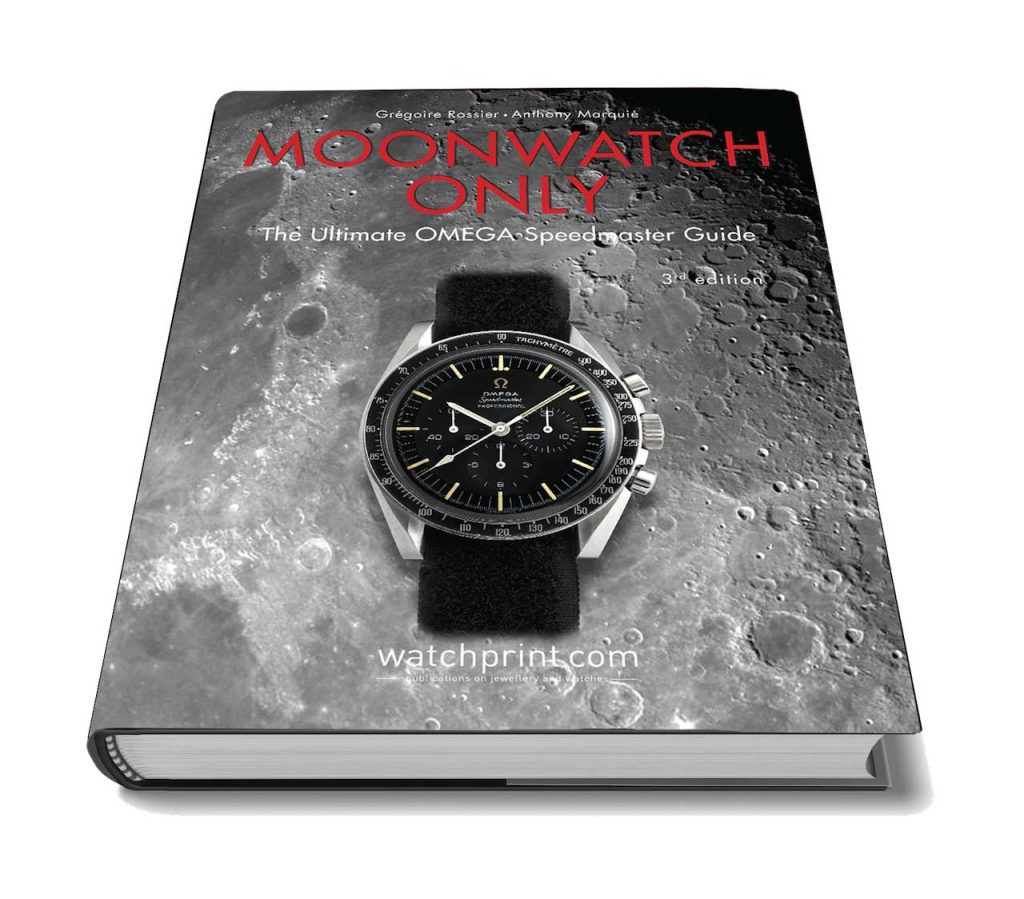
Moonwatch Only, the 3rd and Latest Edition
Why We Love the Speedy
When it comes to sports chronographs there is none other that is as soaked in lore as the Omega Speedmaster. The watch was created for the expressed needs of auto-racing and featured a tachymeter — a scale that combined with the chronograph’s sweep seconds hand could give you your average speed over fixed distance. This bold, modern scale was printed on the watch’s bezel making it the first contemporary timepiece with this feature and forged the genetic blueprint for all sport chronographs from this point on.
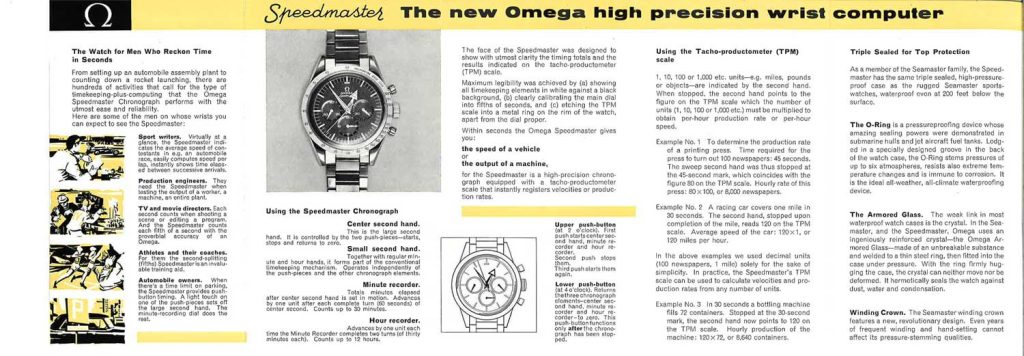
Omega Speedmaster Ad for the 1957 CK2915 (Image: omegawatches.com)
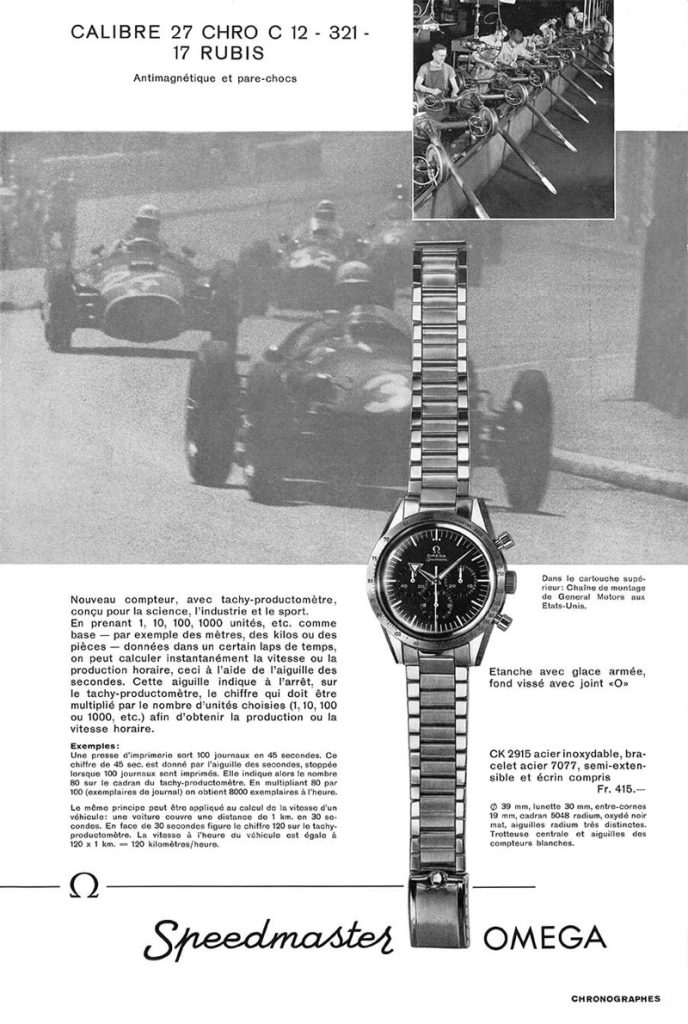
Omega Speedmaster Ad for the 1957 CK2915 (Image: omegawatches.com
The first Speedmaster that went unofficially into space, as the personal watch of Mercury astronaut Wally Schirra, on October 3rd 1962, was the CK2998. This was a full three years before NASA officially went through the rigors of certifying the Speedmaster “Flight Qualified for all Manned Space Missions”.
It is important to note that all watches that went to space officially whether reference 105.003, 105.012 or 145.012 or even Schirra’s CK2998 featured the calibre 321, the single most famous manual wind chronograph movement of all time, created by a company named Lemania that Omega would eventually merge with.

Buzz Aldrin in the Apollo 11 Lunar Module, his Omega Speedmaster ST105.012 in clear view (Image: NASA.gov)
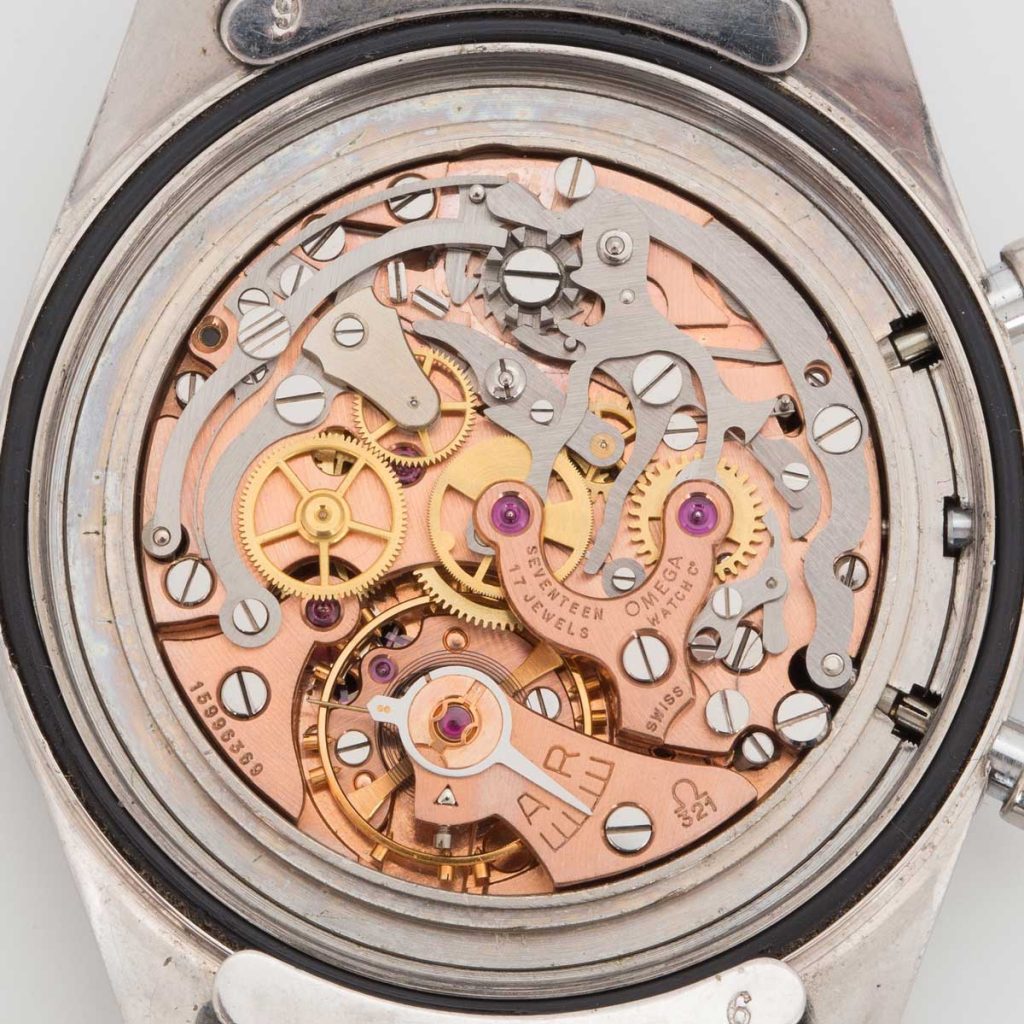
The Calibre 321 is Omega's adaptation of the venerable Lemania 2310, better known to the watch collecting community as the CH 27 (Image: Bukowski Auction House)
Soon after, the crew lost the majority of power to the craft. They knew that their only option for survival was to use the moon’s gravitational pull to slingshot them around and back to earth. But there was one major problem — the angle of the craft’s re-entry. Too steep and it would burn up upon re-entry; too shallow and the craft would bounce off earth’s atmosphere, leaving the crew floating helplessly into space.
Using Jim Swiggert’s Omega Speedmaster, the crew used the lunar module’s manually controlled descent propulsion engine to create 14 second mid-flight course correction. This allowed them to re-enter the earth’s atmosphere successfully causing both the astronauts and the watch that saved them to indelibly become inked into one of the most remarkable moments in human history.
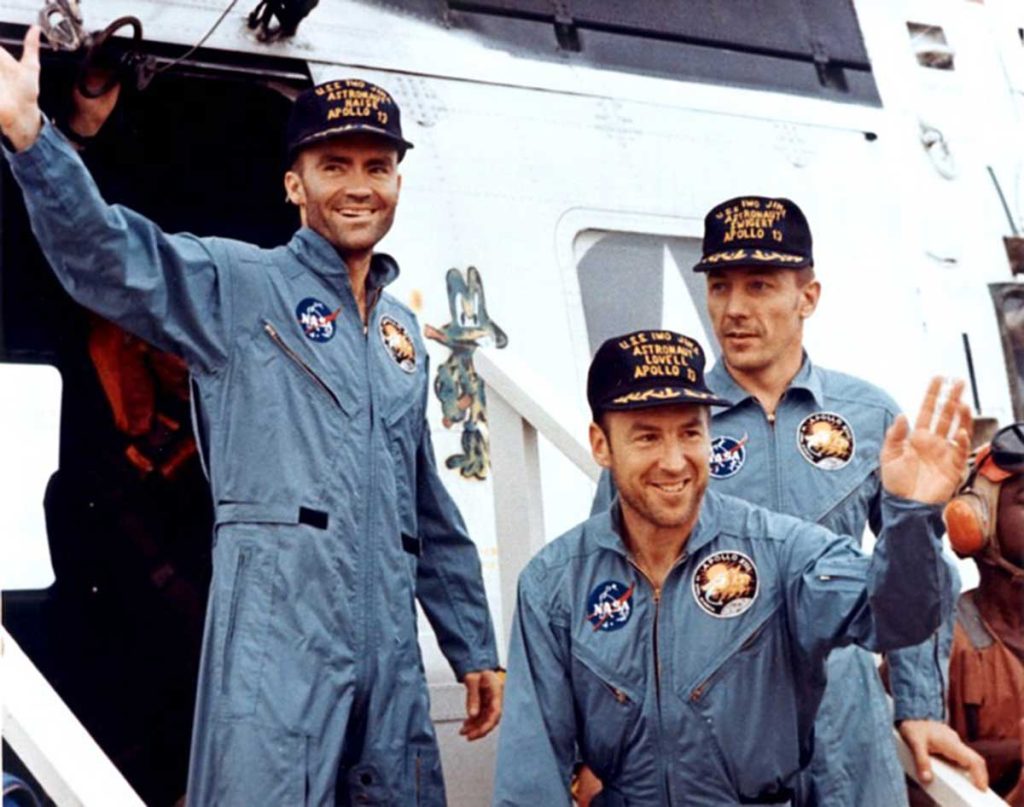
The Apollo 13 crew — Fred Haise (left), Jim Lovell (center), and Jack Swigert — step aboard the “USS Iwo Jima” following splashdown and recovery operations in the south Pacific Ocean on April 17, 1970 (Image: NASA.gov)
The Blockbuster Speedmasters
1957 Reference CK2915 — The Original
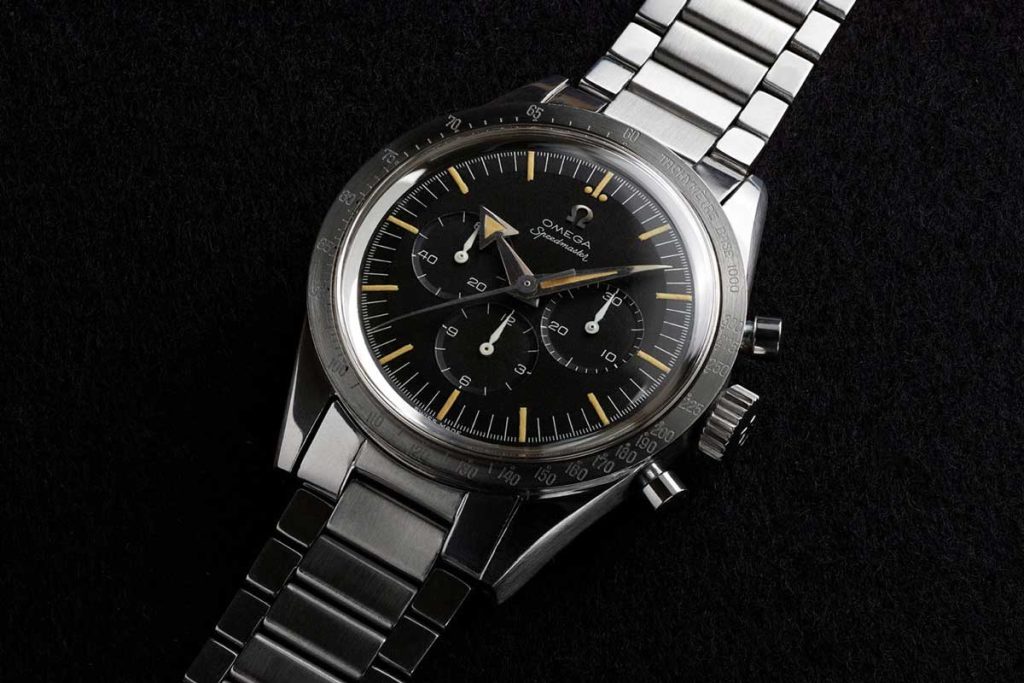
1957 Reference CK2915 — The Original (Image: omegawatches.com)
Prices for truly original ref. CK2915s, made in three series from 1957-1959, now command six figures. Omega believes that perhaps 4,000-5,000 were produced, of which only 20 or so are estimated to be in good or near-perfect condition, with another 50 being “so-so.”
Exercise caution when buying: Omega was recently offered a CK2915-1, the very first reference, but while the movement was correct, the case and dial colour were original, the watch bore the wrong bezel, hands and luminous material. What looked to be “the best 2915 ever” turned out to be something “no museum would touch.”
At the top level, one sold for £230,000 last year, another for CHF280,000 including buyer’s premium, while one collector paid nearly CHF200,000 in a private sale. Petros considers it, however, to merit higher prices. On 12 May, Phillips sold a 2915-1 for CHF 408,500 against an estimate of CHF 80,000-140,000.
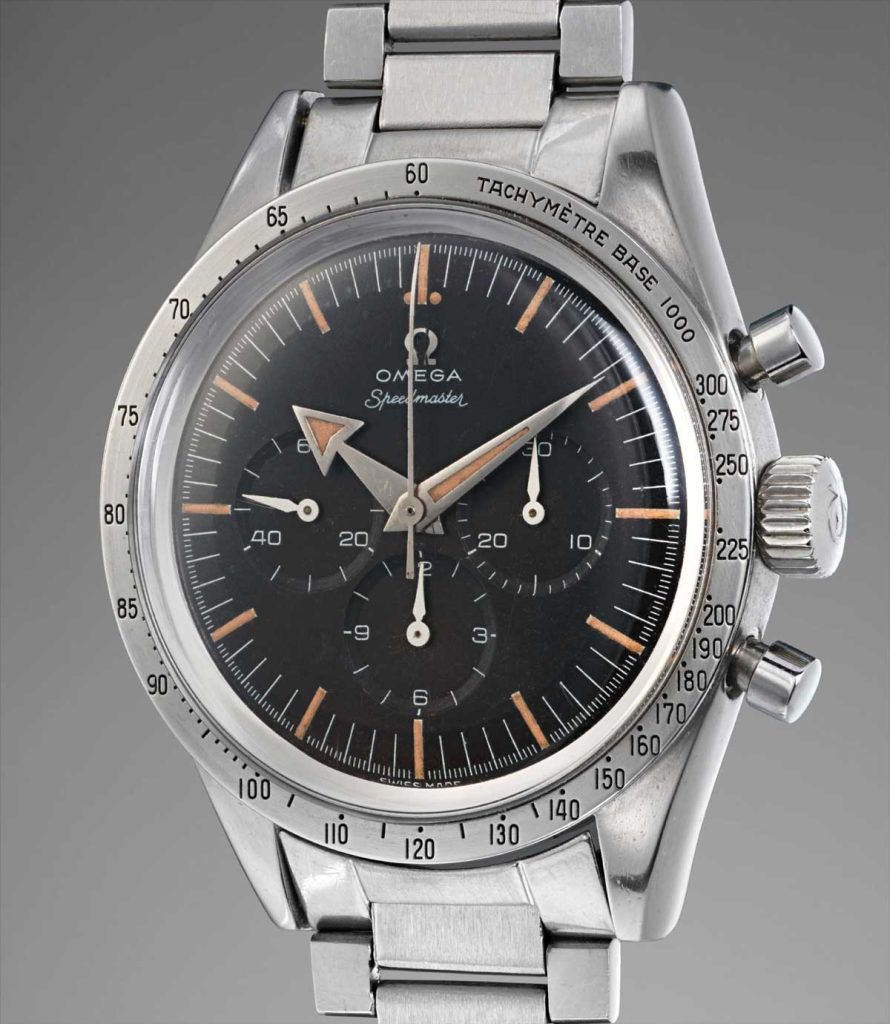
The Omega Speedmaster launched in 1957 was the very first chronograph with the tachymeter featured on the bezel of the watch; it was also one of the first Omega watches to use the Lemania 2310-based calibre 321; seen here is the CK2915-1 sold by Phillips, at their Geneva Watch Auction on 12 May 2018, for CHF408,500 against an estimate of CHF 80,000-140,000 (Image: phillipswatches.com)
1959 Reference CK2998 — The Second Generation
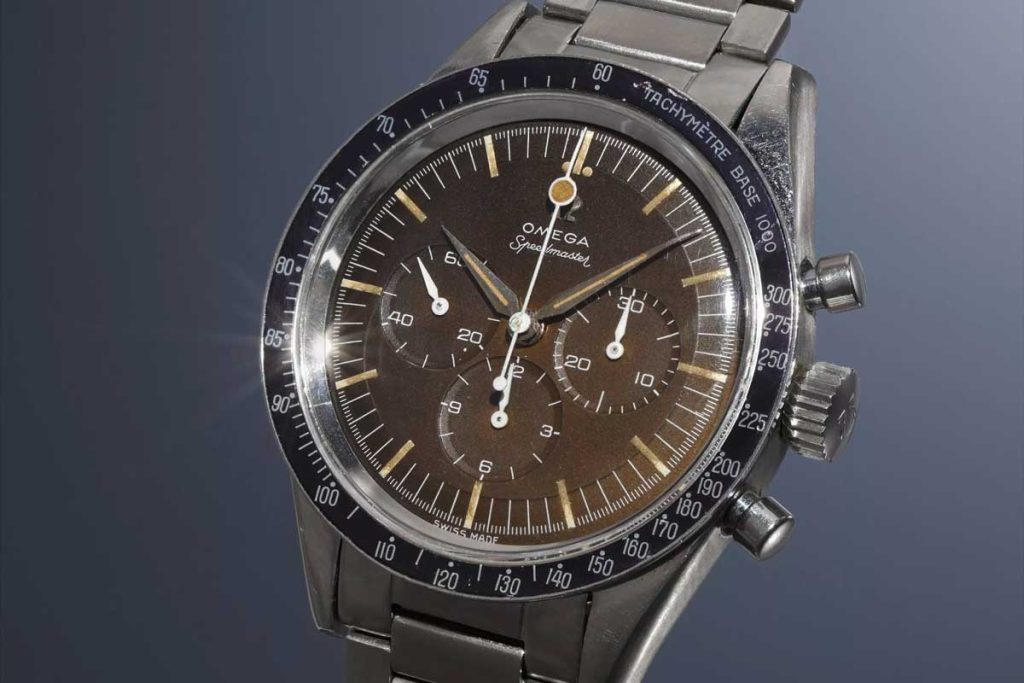
A 1960 CK2998-1 with the incredibly sought-after lollipop seconds hand (Image: phillipswatches.com)
Astronauts Walter Schirra and Gordon Cooper bought their own Speedmasters in Houston; Cooper was already an Omega Seamaster owner since 1956/7; one in 14k gold received when he graduated as a pilot. When he needed a watch, he bought the Omega thanks to brand loyalty (which he confirmed in writing). Schirra checked his potential purchases for legibility in-store, and took every chronograph and literally shook it “to death” while trying to read it. The Speedmaster passed his tests.
Eight variants of the CK2998 appeared in its four years, with sub-references numbered CK2998-1 onwards, all distinguished by “alpha” hands. These can vary in length if they have been replaced in service, but the longer minute hands, with tips reaching all the way to the minute graduations, are correct. The price range is vast: One sold for $100,000 last year, while at Phillips’ Geneva auction this May, a CK2998-3 commanded only CHF20,000, yet a CK2998-1 minus bracelet sold for CHF62,500.
1962 Reference ST 105.002 — A Transitional Reference
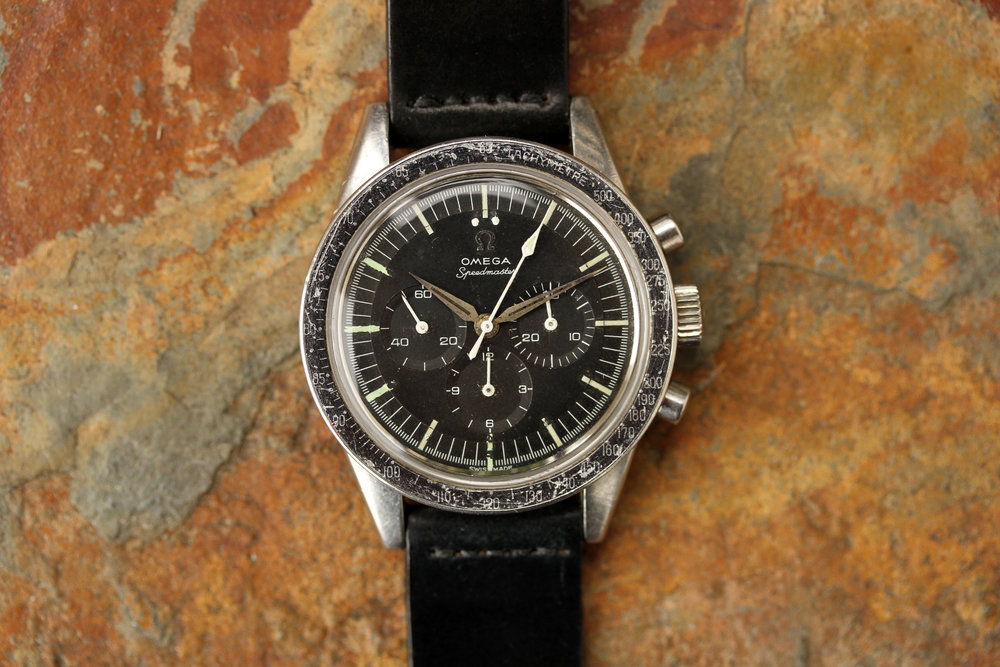
1962 Reference ST 105.002 seen here with Alpha hands — A Transitional Reference (Image: lunaroyster.com)
The ST105.002 can be found with Alpha and Baton hands. It was the last Speedmaster to feature the silver rehaut under the crystal with SWISS MADE written on the dials, with no T (indicating the use of radium as opposed to tritium).
1963 Reference ST105.003 — The Ed White
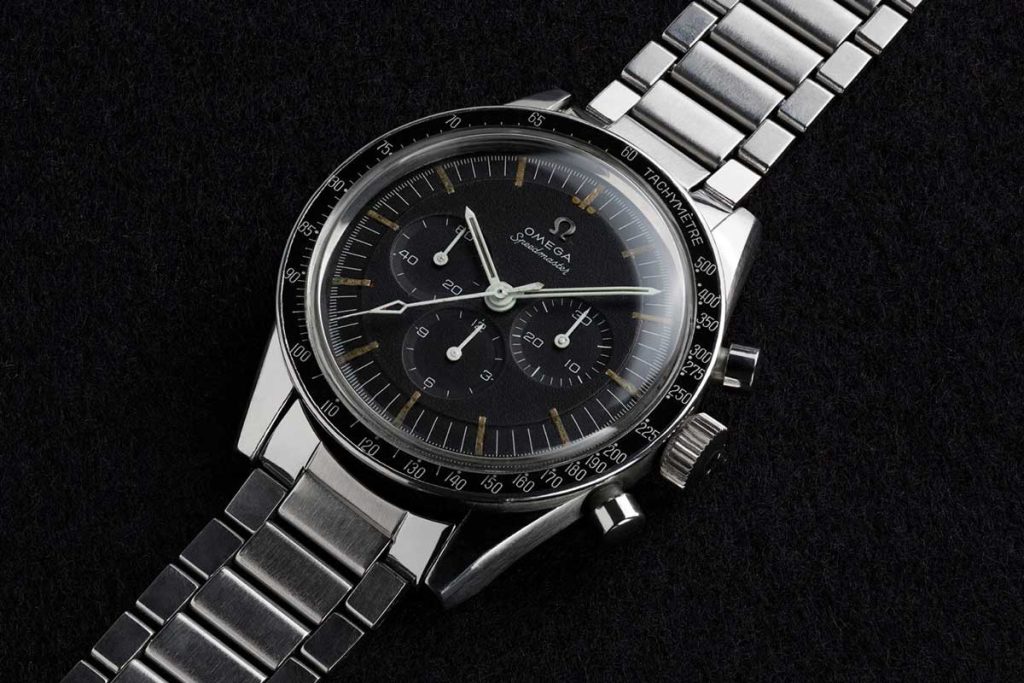
The third generation of the Speedmaster, the 1963 ST 105.003 (Image: omegawatches.com)
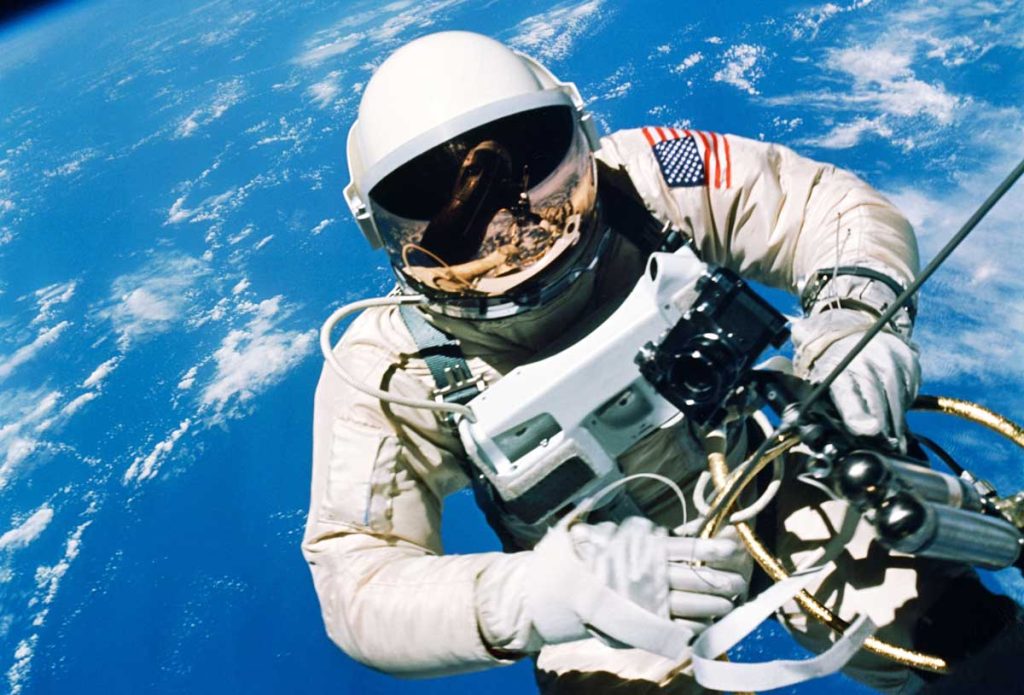
Astronaut Ed White floats in the microgravity of space outside the Gemini IV spacecraft; his ST 105.003 on a black velcro strap, clearly visible on his left wrist (Image: NASA.gov)
1965 Reference ST105.012 — The First Watch on the Moon
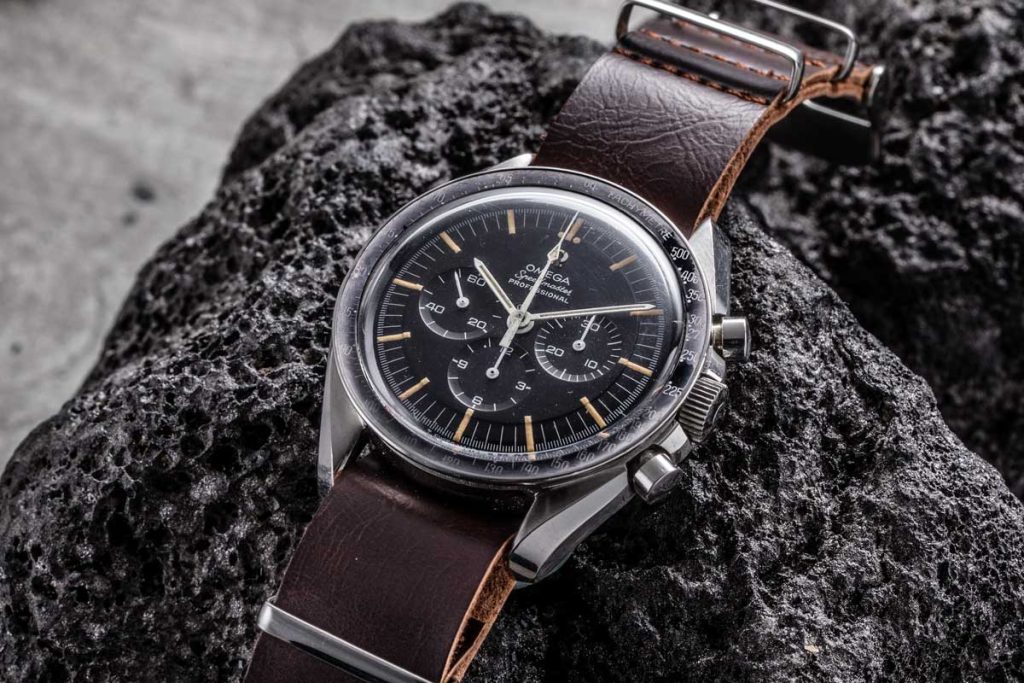
1963 Reference ST105.012 — The First Watch on the Moon (© Revolution)
NASA only tested watches with Calibre 321 at the time, and for all of their original deliveries for Gemini and Apollo, they only received 105.003, 105.012 and 145.012. This is important for those who only want models identical to those used by NASA. It is believed that NASA acquired 98 watches in total, and the astronauts had a pool of watches from which to choose.
Most noteworthy about the 105.012, is the first appearance of the asymmetrical case, with protective shoulders for the pushers and the crown. This appeared a month before the “Ed White,” and Buzz Aldrin wore this more common style case. It pains this writer to note that he once purchased a 105.012 for US $250. Now, one would expect to pay £15,000.
Note that in 1966 cases for the 105.012 watches were made by two case makers La Central Boites and Hueguenin Freres. The watches made by the former feature an additional step on the top of the lugs that is sometimes polished by accidentally during service.
1967 Reference ST145.012
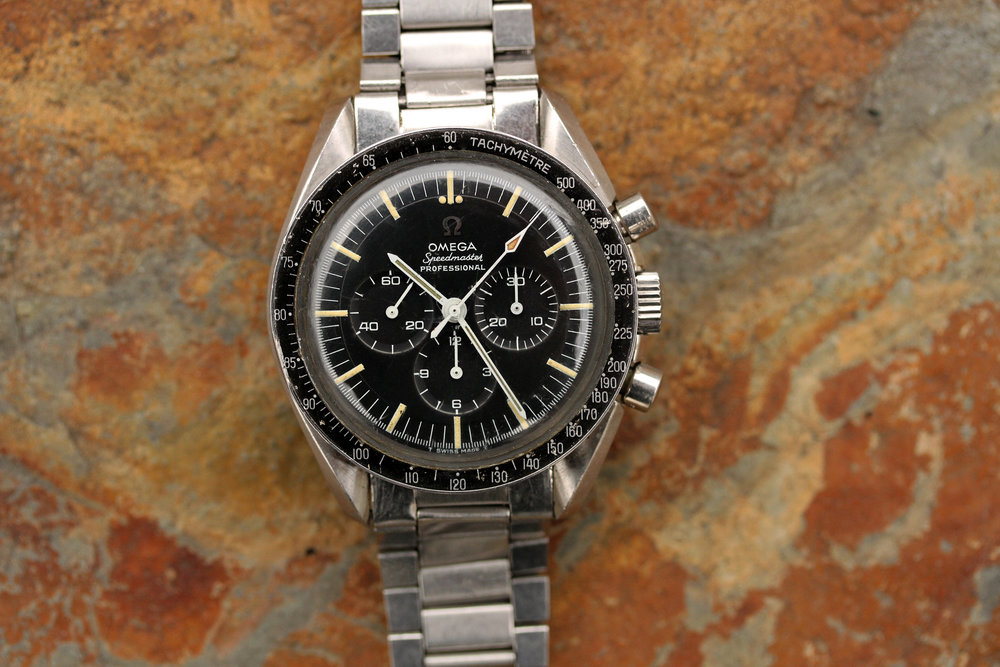
1967 Reference ST145.012 (Image: lunaroyster.com)
1967 Reference ST145.012 — Black Racing Dial
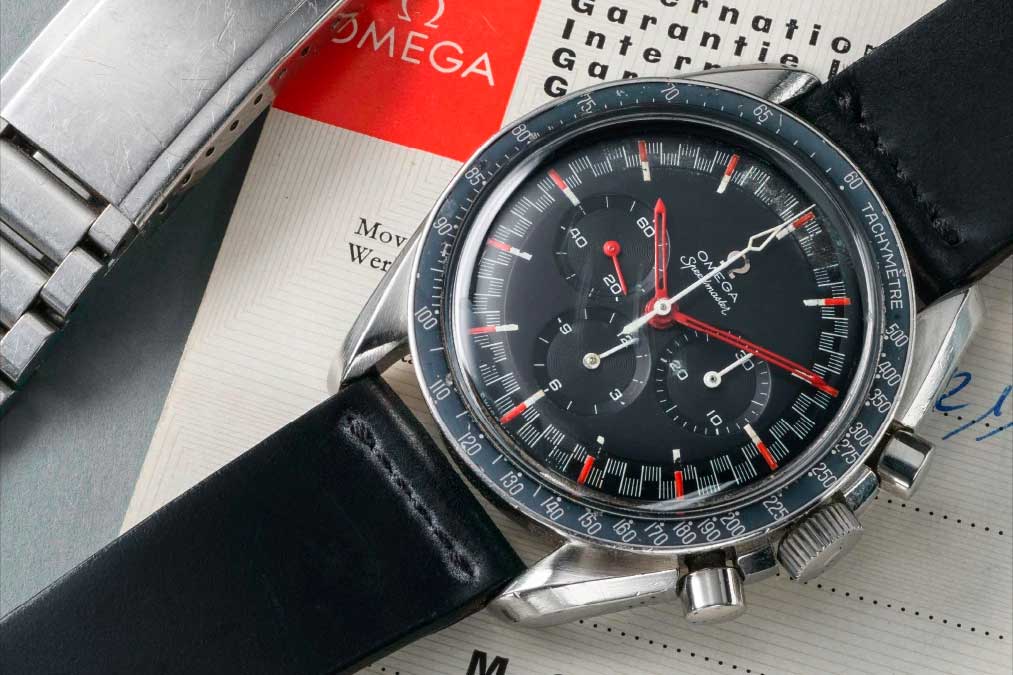
The ST145.012 with the Black Racing Dial, sold by Phillips at their 12 May 2018 sale; sold for CHF40,000 (Image: phillipswatches.com)
How it came into existence is due to the times: the late 1960s saw exotic dials appearing on a number of watches, “a modernisation of an existing reference,” says Petros. However, it never received its own model designation, leaving the factory with a racing dial, but this is compounded by another discovery made by Omega: the possibility existed at the time that certain Speedmaster orders from certain retailers were supplied with two different dials, and the client could be offered the choice between standard and flamboyant.
While Daniel Somlo suggests that possibly as few as 20 exist, Petros is more optimistic, thinking numbers may extend into the low hundreds, “but that doesn’t mean all of them survived.” This model’s rarity has inspired fakes, Daniel mentioning that he has been offered them, so care is needed to assure authenticity. While the consensus is that around £100,000 is needed to acquire one, Phillips sold one on 12 May for CHF40,000, at just over double the upper limit of its estimate.
1968 Reference ST145.012 — Ultraman
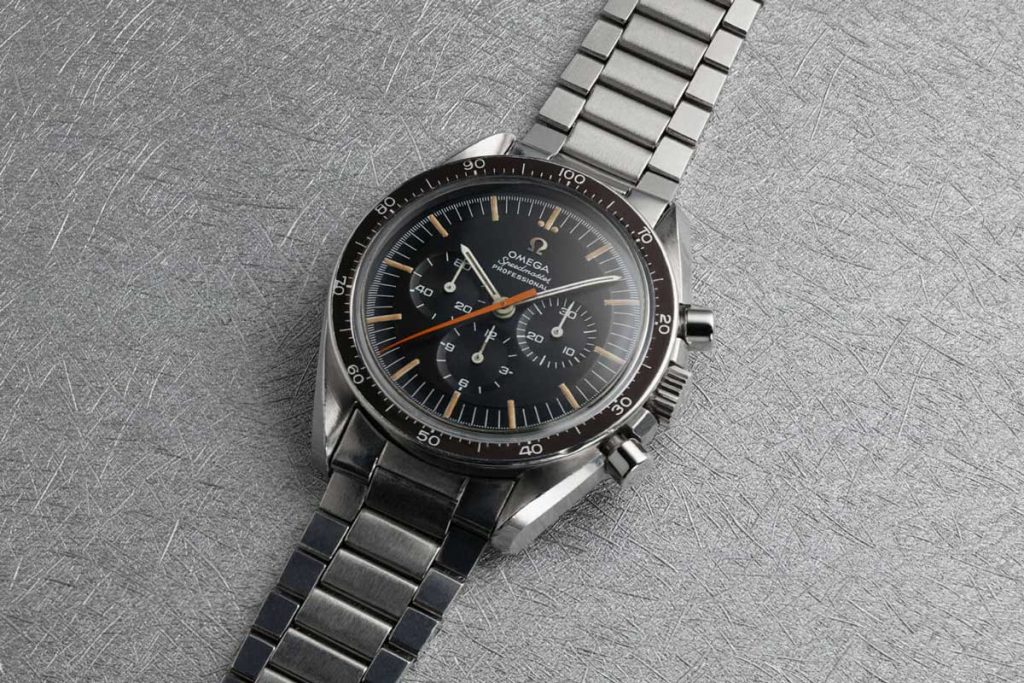
The Reference ST145.012 — Ultraman watch, featuring the 18.80mm orange chronograph seconds hand; the example seen here features a uncommon bezel (Image: omegawatches.com)
1968 Reference ST145.022-69
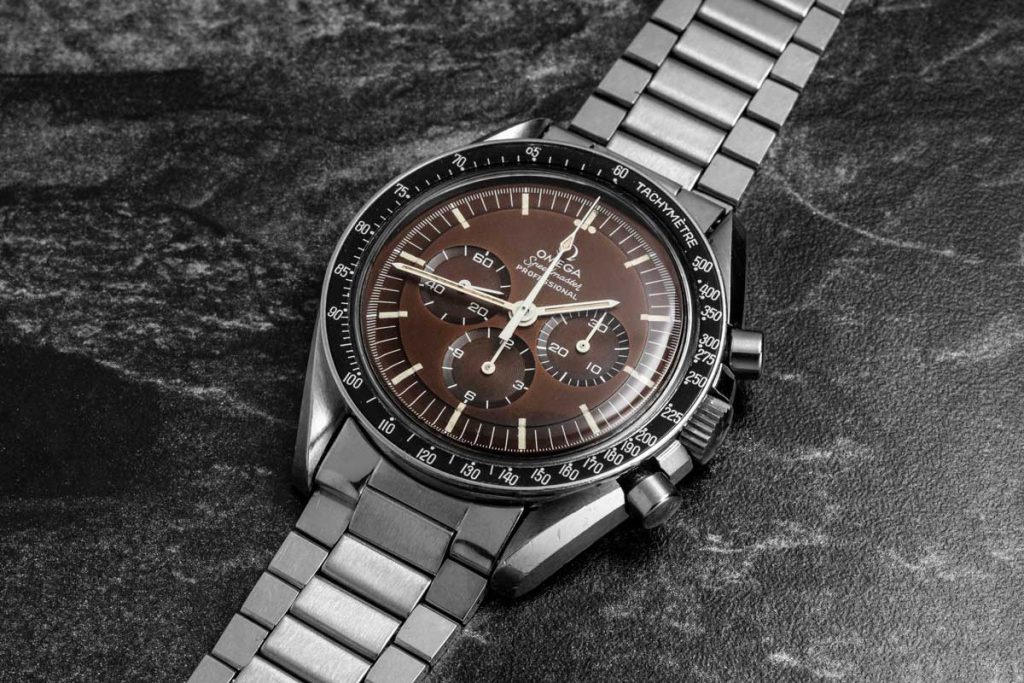
Lot 944 at the Phillips Hong Kong watch sale on 29 May 2018: A 1970 Speedmaster ref. ST140.022-69 that has developed a deep brown patina on its dial (© Revolution)
Some of the most brown, chocolate or brown patina dial Speedmasters occur within this reference, as well. These dials result from a faulty UV coating in reaction to age and exposure to heat and light. Our friend, William Roberts, aka Speedmaster101.com tells us that these watches should appear in units with movement numbers 29.11X.XXX to 29.60X.XXX, while the book Moonwatch Only puts the movement numbers slightly wider as 29.110.XXX to 31.009.XXX.
1969 Yellow Gold Omega Speedmaster Tribute to Apollo XI Reference ref. BA 145.022
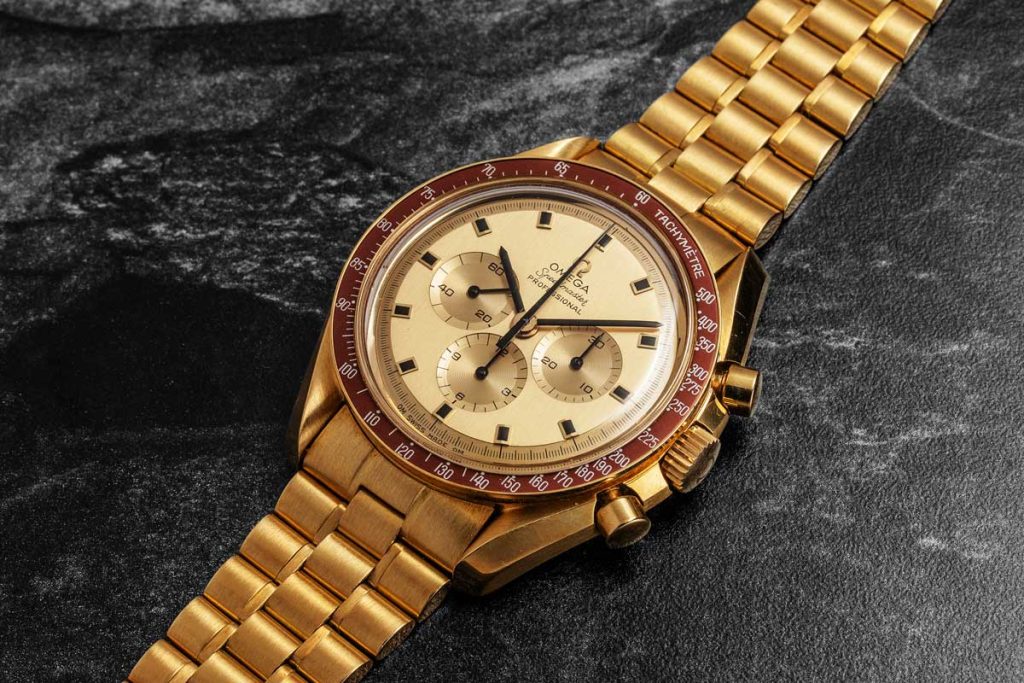
Lot 808 at the Phillips Hong Kong watch sale on 29 May 2018: A 1969 Yellow Gold Omega Speedmaster Tribute to Apollo XI Reference ref. BA 145.022 (© Revolution)
This model, of which just 1014 were manufactured during 1969-1973, was offered to the President and Vice-President of the United States and the active astronauts, each engraved with the recipients’ names, with numbers 33 – 1000 sold to the public. As neither President Richard Nixon nor Vice-President Spiro Agnew were allowed to accept such gifts, theirs are now in the Omega Museum.
Categorically an undervalued item, this highly desirable model only fetched around £20,000-£25,000. But as of 2018 it seems poised for a major leap in price with an example recently sold with Phillips in Hong Kong for US$45,900 (before buyer’s premium).
Read Wei Koh’s complete story about this watch, here.
1969 “The 220 Misprint” Bezel
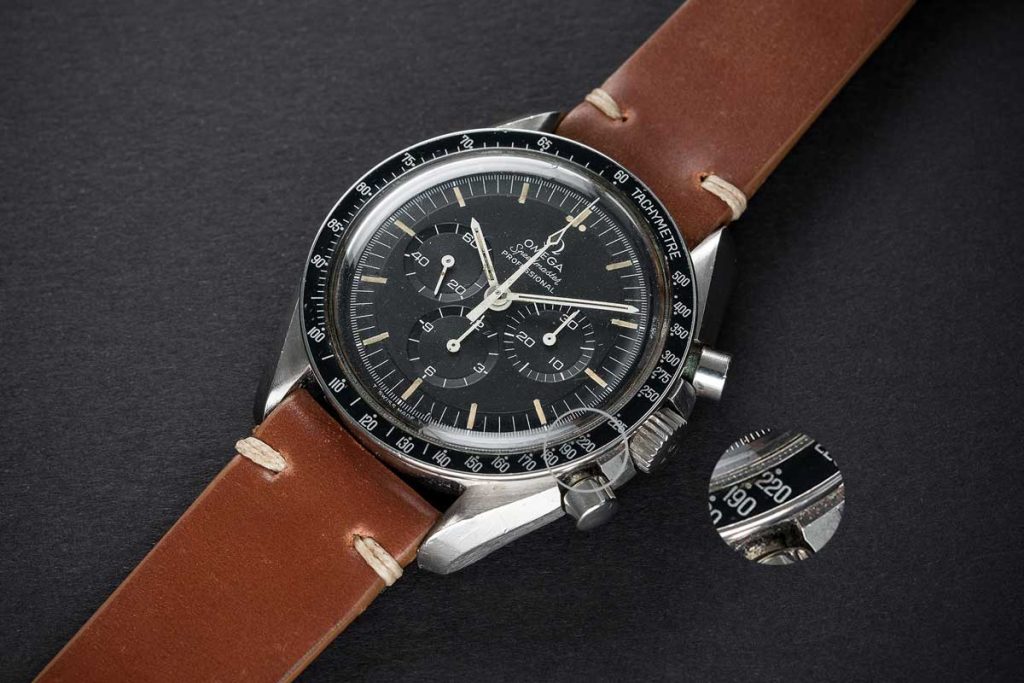
A 1970 ST145.022 with the 220 misprint bezel insert (Image: watchesofknightsbridge.com)
Says Petros, “It’s a technical misprint, it’s nothing more. The watch is the exact same as the regular model but collectors love it.” Despite being a “normal” Speedmaster Professional, its erroneous numbering endows it with a value of circa-£10,000-£12,000, though some are said to have sold for as high as £20,000.
1969-1979 — The Alaska Projects I-IV
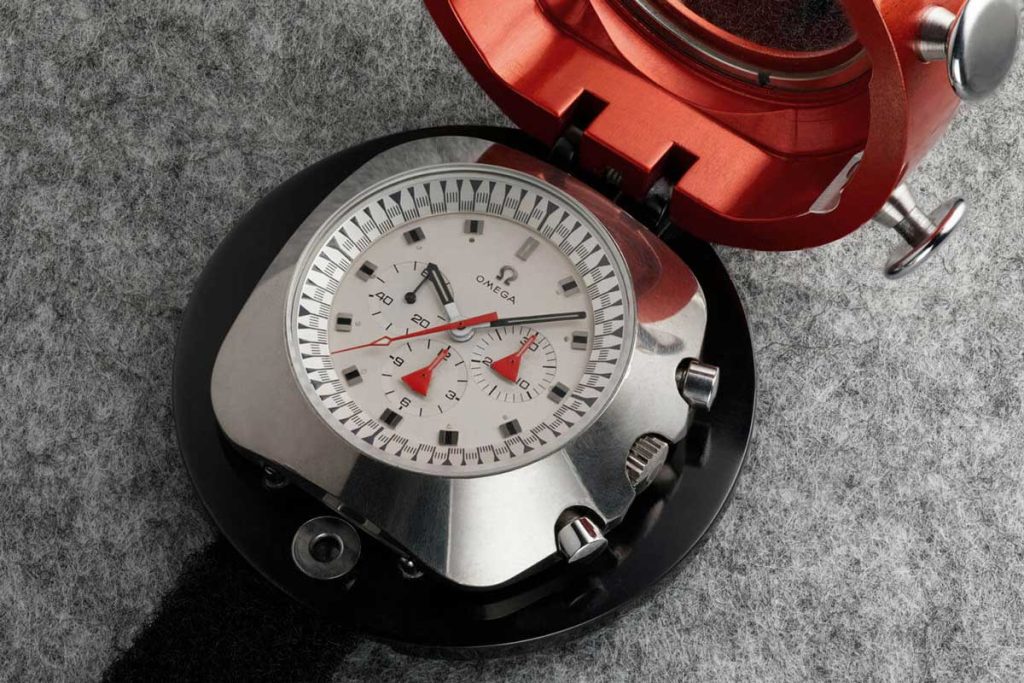
The 1969 Alaska I prototype with its bright red aluminium heat shield, the world's first titanium wristwatch (Image: omegawatches.com)
Petros says that, should a real Alaska I prototype appear on the market, “We would bid on it”; the company recently acquired Elvis Presley’s diamond-bezel Omega in auction for $1.8m. Petros says “I would be surprised if it fetched less that £250,000 to £300,000, and I can think of at least ten collectors would be bidding.”
In the 12-13 May auction held by Phillips, a Prototype Alaska III Ref. ST 188.0002 stainless steel electromechanical prototype chronograph wristwatch with day and date, delivered to NASA in 1978, was entered with an estimate of CHF10,000-20,000. The hammer came down at CHF162,500. After actual astronauts’ Speedmasters, any of the watches produced for the four Alaska Projects would be the ultimate items in any Omega collections.
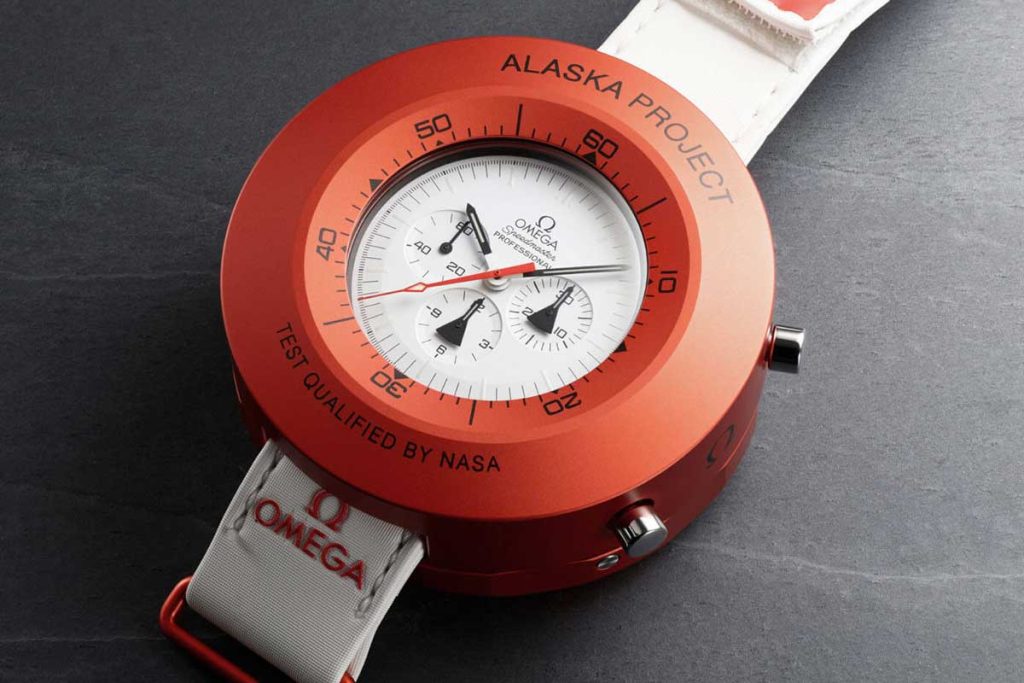
Created in a limited edition of 1,970 pieces in 2008, the watch is based on the “Alaska II” project which used a “standard” Speedmaster with a modified dial and hands in conjunction with an outer anodized aluminium “thermal shield”. (Image: omegawatches.com)
1970 Reference ST145.022-69 — Grey Racing Dial
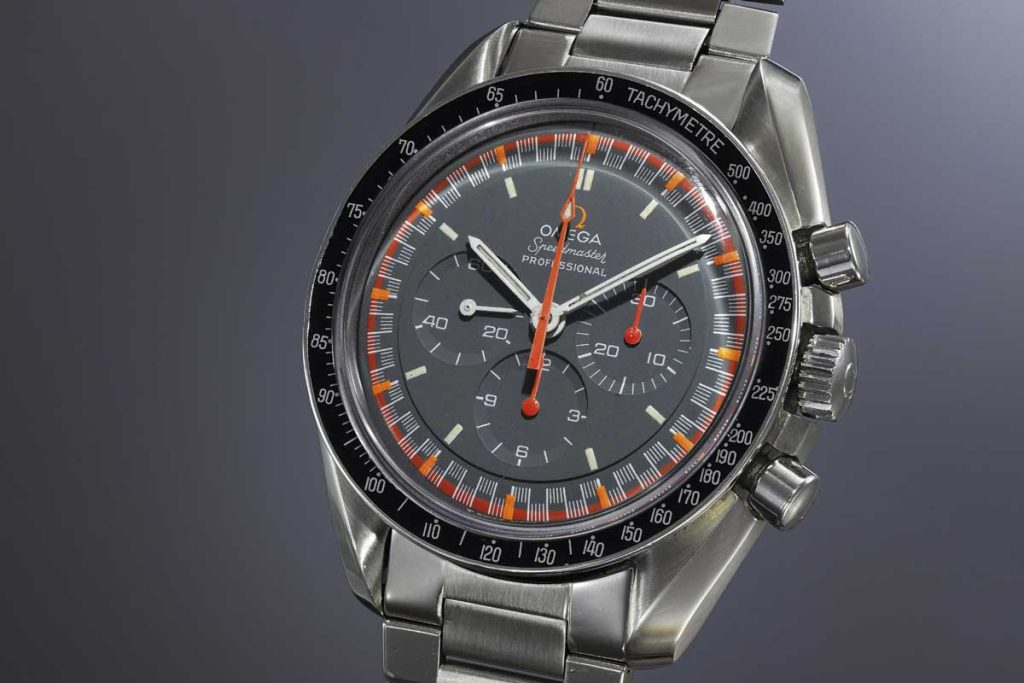
1970 Reference ST145.022-69 — Grey Racing Dial (Image: phillipswatches.com)
1992 Reference BA 148.0052 — First Yellow Gold Speedmaster with Black Dial
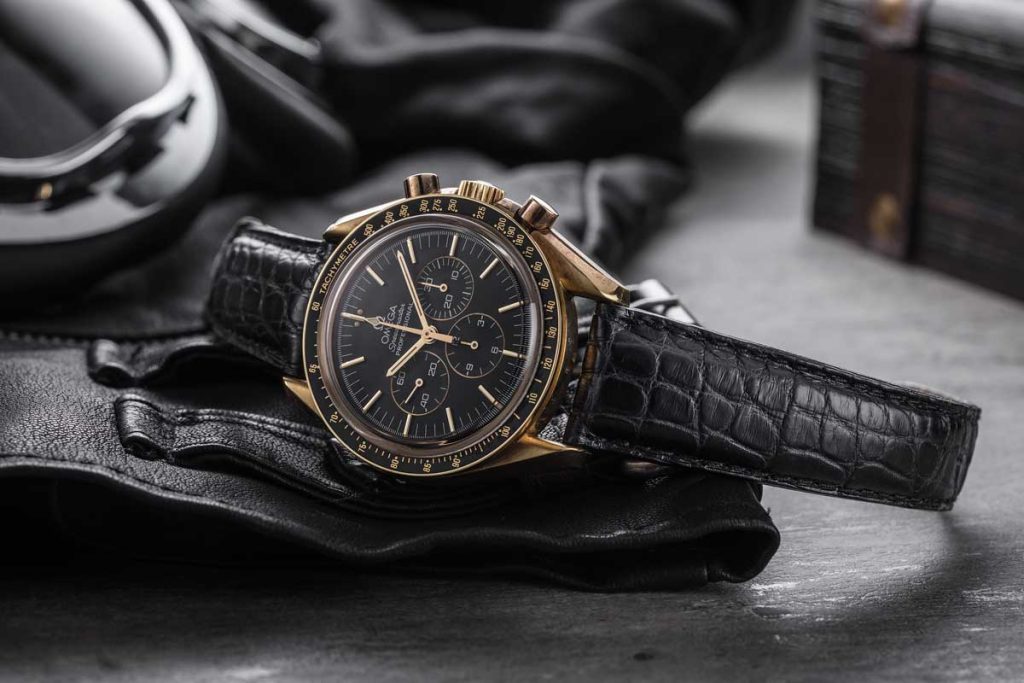
1992 Reference BA 148.0052 — First Yellow Gold Speedmaster with Black Dial (© Revolution)
But best of all, and first reason why this watch is cool, is because this is the watch that Omega issued to celebrate the mighty calibre 321. The 27 CHRO C12 project that Omega launched in 1942, which ultimately yielded the 321, turned 50 in 1992. Therefore, on this occasion, Omega fit this special watch with the COSC certified calibre 864, which made this the first COSC certified manual wound Speedy.
2003 Reference PIC 3578.51.00 — The Blue Snoopy
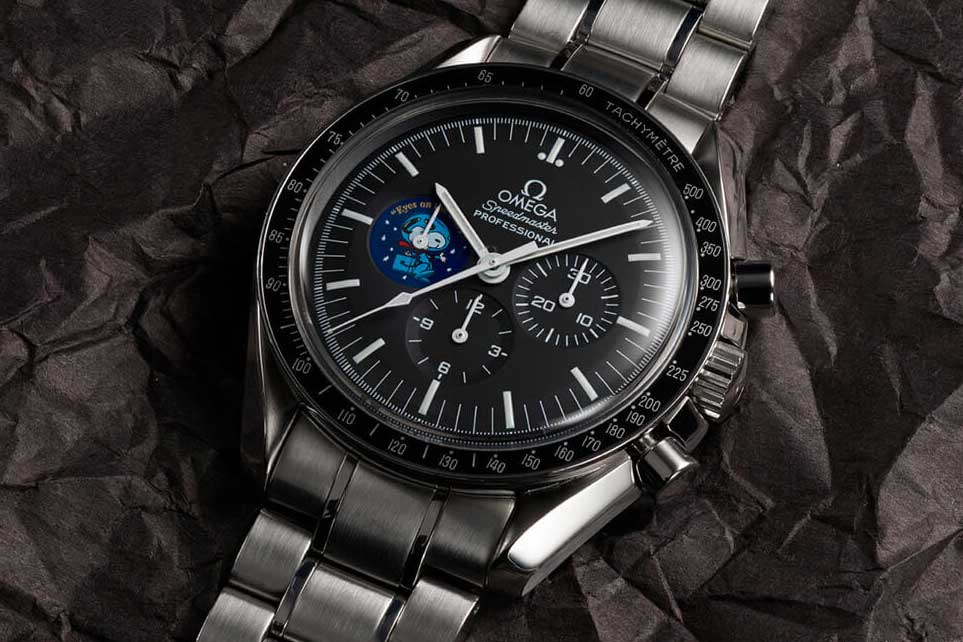
The commemorative 2003 Reference PIC 3578.51.00 — Blue Snoopy (Image: omegawatches.com)
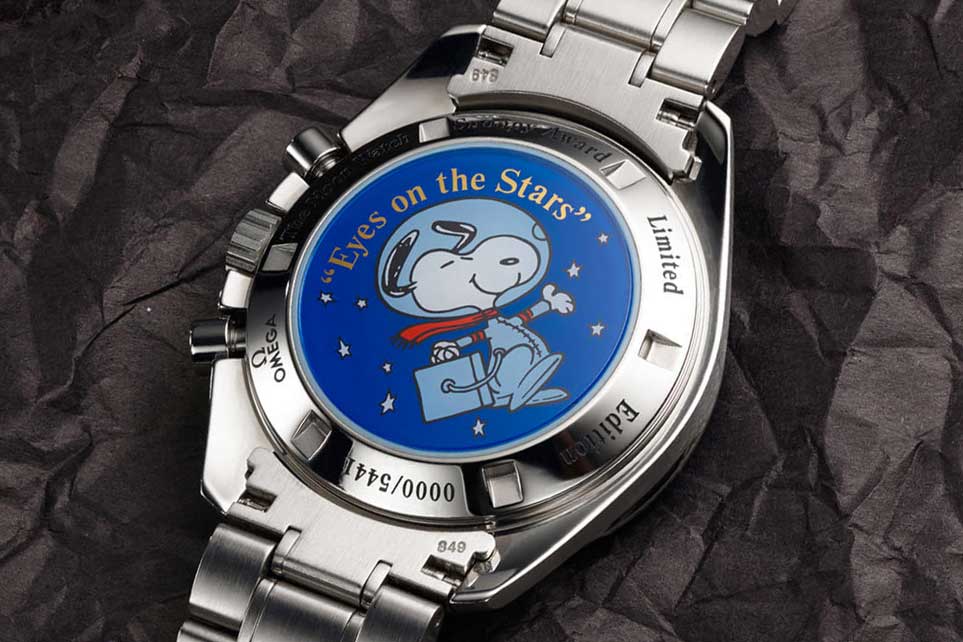
The commemorative 2003 Reference PIC 3578.51.00 — Blue Snoopy (Image: omegawatches.com)
NASA first presented Snoopy awards in 1968, with the support of Peanuts creator Charles Schulz, an avid supporter of the US space programme. A further connection came with the Apollo 10 mission, when Peanuts characters were used as calls signs. Omega received a Silver Snoopy award in 1970 after its involvement in the now-famous Apollo 13 mission, when Jack Swigert’s Speedmaster timed the critical 14-second fuel burn to put the craft on course for Earth.
In 2003, Omega released PIC3578.51.00, with Snoopy in a blue astronaut’s suit, on a black dial, in an edition of 5441 pieces — in reference to the length of the Apollo 13 mission — 142 hours, 54 minutes and 41 seconds. These easily command £12,000-£15,000. Not far behind is the white-dialled Silver Snoopy Award of 2015, issued in an edition of 1970 watches, with prices already reaching £10,000.
2003 Reference PIC 3570.31 — The Mitsukoshi Special Edition
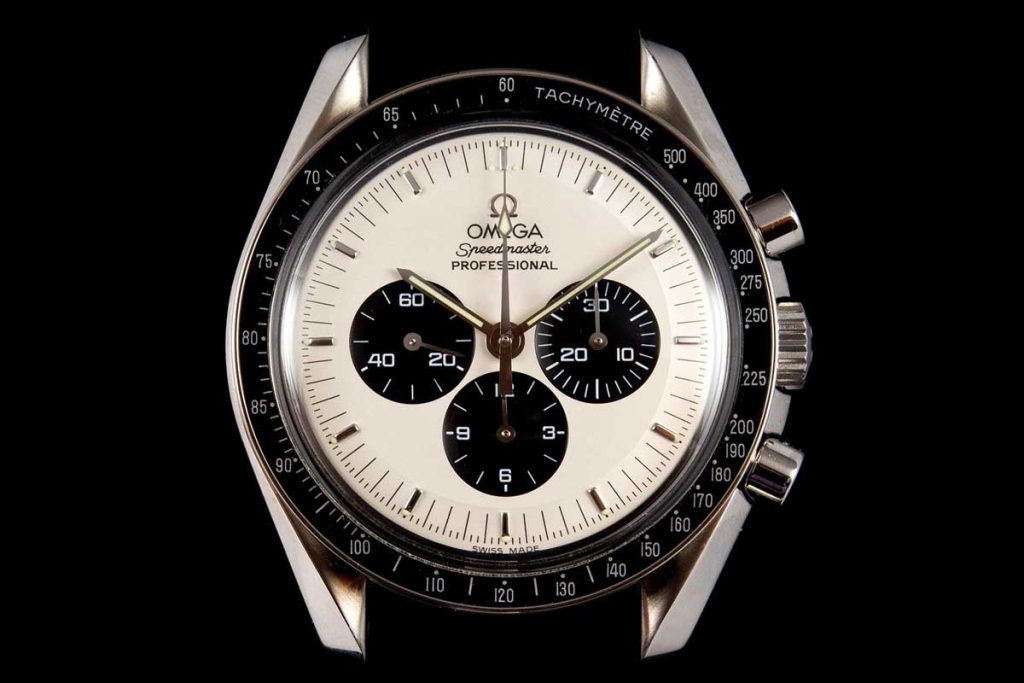
The Mythical 2003 Reference PIC 3570.31 — The Mitsukoshi Special Edition (Image: moonwatchonly.com)
In 2004, Omega celebrated the 35th anniversary of the Apollo 11 mission with yet another panda dial Speedmaster, the reference PIC 3569.31.00. However, this one’s easy enough to tell apart, as it has the date July 20, 1969 — the day the Apollo 11 crew landed on the moon — printed in red at 12 o’clock.
2004 Reference 3570.40 — Japanese Racing Dial
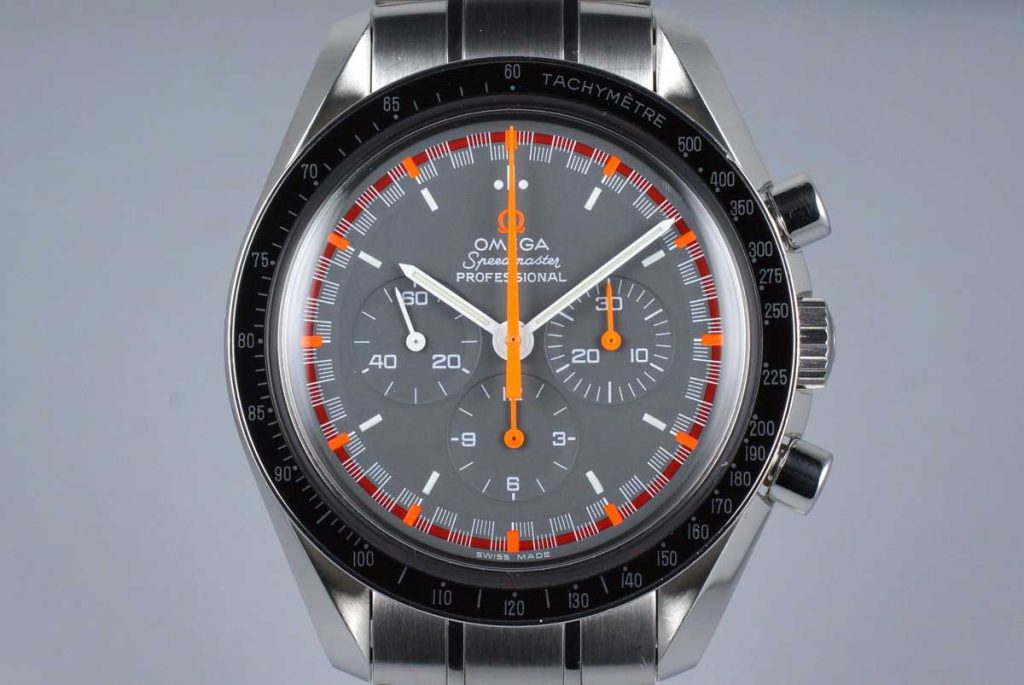
The 2004 Reference 3570.40 — Japanese Racing Dial (Image: hqmilton.com)
An instance of the watch was sold with Phillips in Hong Kong on 29 May, for just shy of US$16,000.
2013 Reference: 311.30.42.30.01.004 — The Tintin
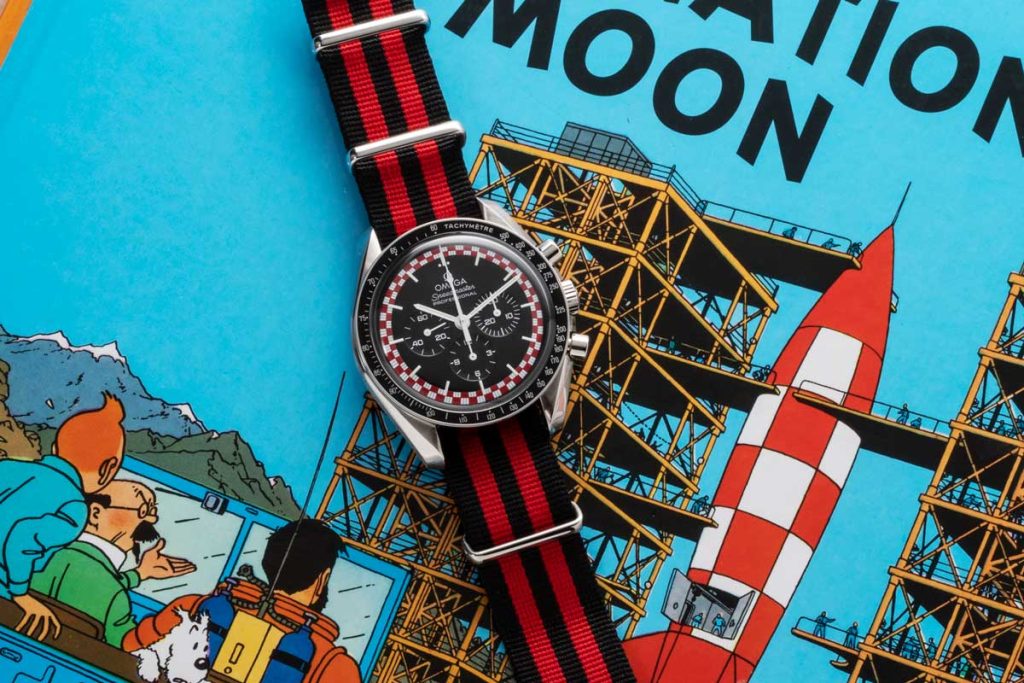
The 2013 Reference: 311.30.42.30.01.004 — The Tintin (© Revolution)
Unfortunately, negotiations with the estate of Herge fell through leaving Omega with these dials and no story to tell — not legally that is. Amusingly, the original design for this watch even featured a miniature rocket ship at 11 o’ clock. Ever the pragmatist Omega repackaged the watch and a red and white Racing dial.
2015 Reference 311.32.42.30.04.003 — Silver Snoopy Tribute to Apollo 13
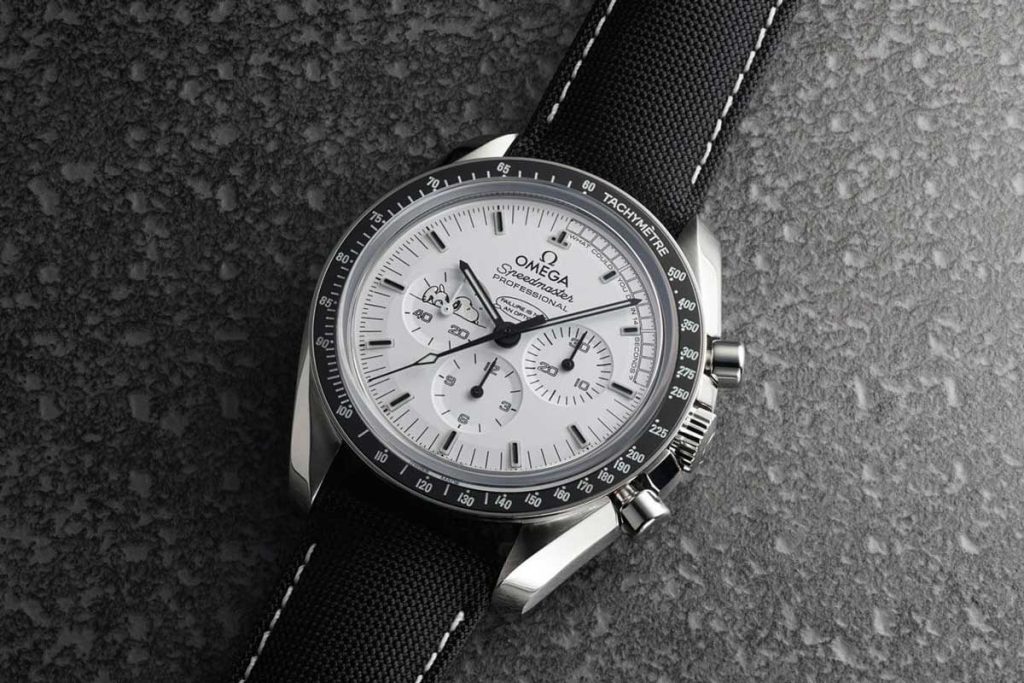
Omega Speedmaster Silver Snoopy Tribute to Apollo 13 (© omegawatches.com)
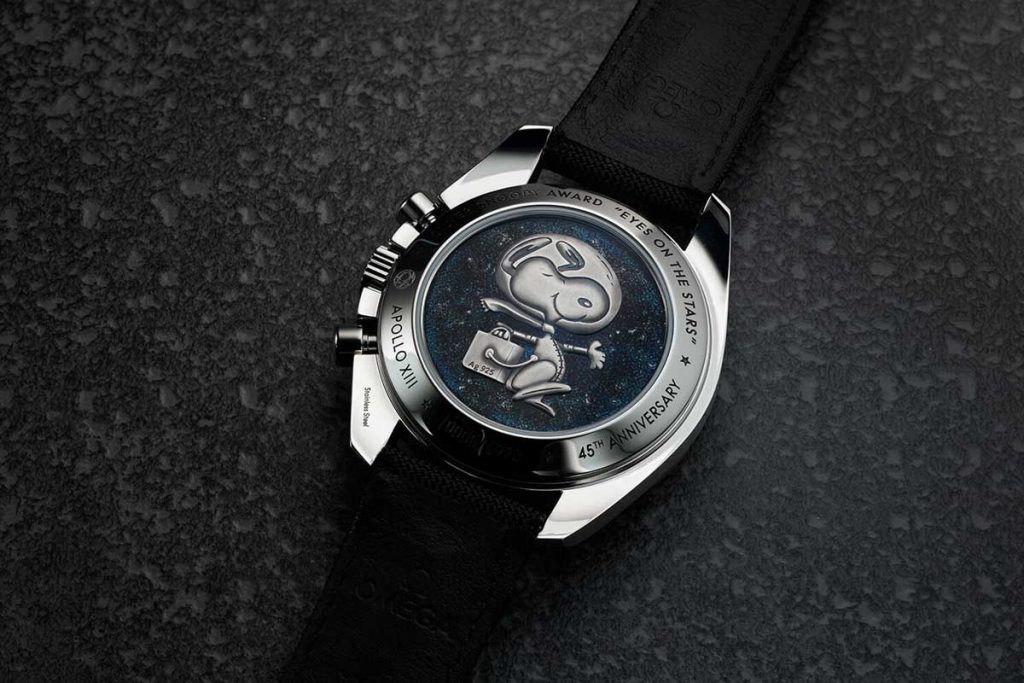
Caseback view of the Omega Speedmaster Silver Snoopy Tribute to Apollo 13 (© omegawatches.com)
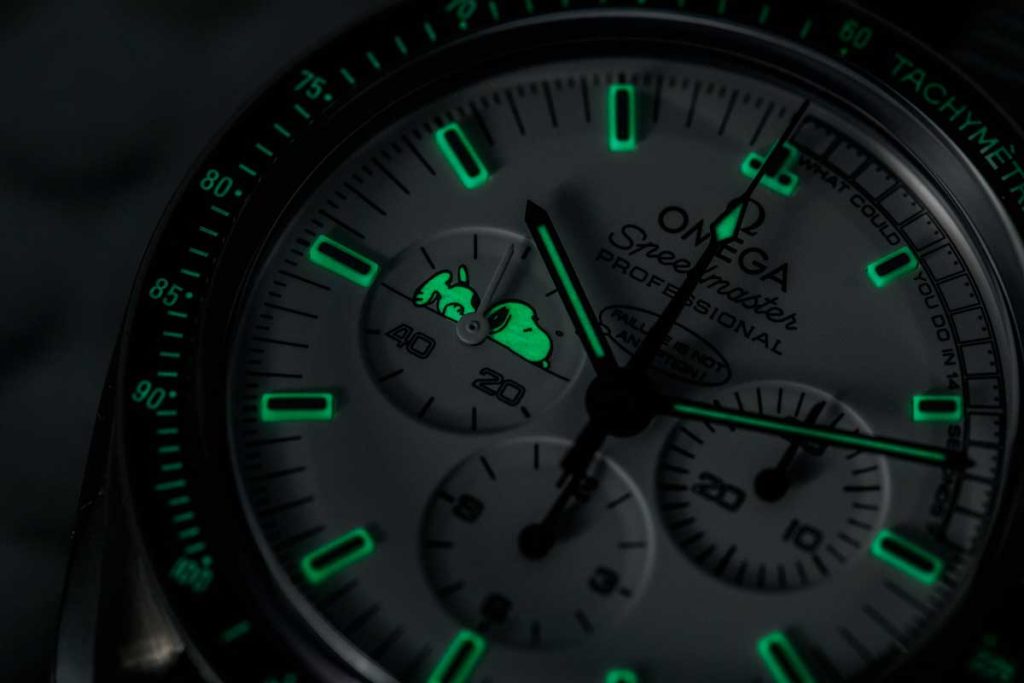
Lume action on the Omega Speedmaster Silver Snoopy Tribute to Apollo 13 (© Revolution)
It features a charming use of Charles M. Schulz’s Snoopy to remind us of the extraordinary heroism of the Apollo 13 astronauts and how, in 1970, they used an Omega Speedmaster for re-entry into the earth’s atmosphere after all on-board electronics failed.
This amazing tribute features a luminous Snoopy in the running seconds subdial, declaring “failure is not an option,” while the seconds track at the perimeter of the dial reads “What could you do in 14 seconds?” referring to the precise amount of time calculated by astronaut Jack Swigert’s Speedmaster for the critical rocket burns that enabled the crew to return to earth unharmed.
The Snoopy Award, one of NASA’s highest honors for “dedication, professionalism, and outstanding contributions in support of the first United States Manned Lunar Landing Project,” was bestowed upon Omega by the Astronauts of Apollo 13 upon their safe return.
This was commemorated in the Silver Snoopy Speedmaster with a hand carved Snoopy figurine set against a backdrop of dark blue enamel found on the watch’s caseback. CEO, Aeschlimann shares, “Of course it’s not the objective but when you see how sought-after these watches are, how much they are trading for on the secondary market and how these prices are set in an organic way by buyers and not by market manipulation, it makes us feel as if we are creating the right kind of timepieces.” And, yes, that is a ceramic bezel with luminous tachymeter on this one.
2017 Reference PIC 311.32.42.30.01.001 — #SpeedyTuesday
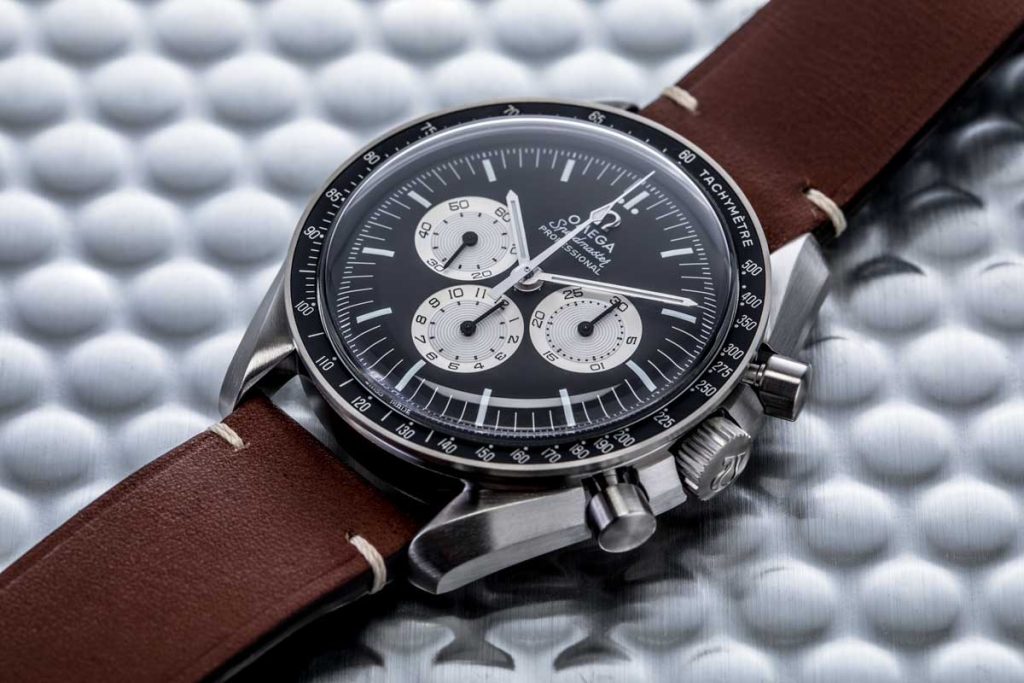
2017 Reference PIC 311.32.42.30.01.001 — #SpeedyTuesday (© Revolution)
If one is very lucky, perhaps £6000 or £7000 might persuade an owner (or, seller perhaps) to part with his or her Speedy Tuesday, while the current online listings go for around £8000-9000, and are still rising. This Speedmaster, like certain Tudors, which will appeal to those who buy watches as investments, who have the willpower to sit on their watches and never wear them, to sell later at a huge profit.
2017 Omega Speedmaster ’57 Chronograph the 1957 Trilogy
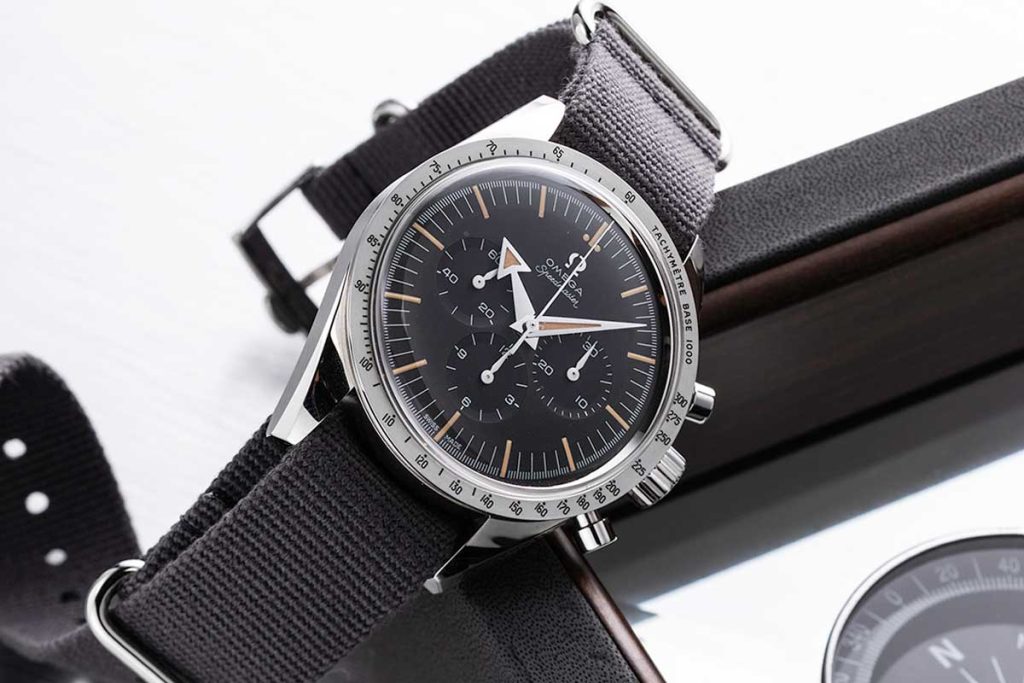
The 2017, Speedmaster '57 issued in likeness to the first Speedmaster Omega made in 1957 (© Revolution)
Measuring 38.6mm and fitted with the period stainless steel bracelet, with reference number 311.10.39.30.01.001, the “Broad Arrow” was the first Speedmaster, as well as the first chronograph wristwatch with its tachymeter scale engraved into the bezel as opposed to printed on the dial. This is perfectly reproduced in the 1957, which is powered by the 1861 calibre and detailed with lume that looks as aged lume should.
If you weren’t quick off the mark, then expect to pay £5000-£7000 for an escapee from the trilogy. And it’s worth it, because this is one of the best-looking Speedmaster reissues to date.










